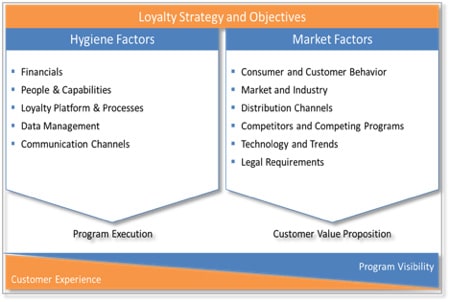Executing a Loyalty Program Checkup is not just about updating the Program Design – A Plea for Considering the Internal Hygiene Factors of a Loyalty Program.
Once implemented and launched, each marketer responsible for a loyalty program needs to answer these challenging questions: How is my program actually performing, and does the program meet the business’s objectives? After investing significant financial and human capital into the program, how can its performance be optimized?
By Nicole Wilhelm
“How is my program actually performing, and does the program meet the business’s objectives?”
With 3.3 billion US loyalty program memberships and an average of 29 loyalty program memberships per US household, companies need to consider that loyalty programs are too powerful as a marketing tool to be missed and too expensive to be executed badly. Currently, 77% of American consumers participate in a retail loyalty program which is a 9% increase compared to 2016. Marketers know that the probability of selling to an existing customer is much higher compared to a new prospect. (60-70% probability to existing customers compared to 5-20% to new prospects).
Research also shows that 77% of members say that loyalty programs make them more likely to continue doing business with brands, 63% modify spending to maximize loyalty benefits, and 70% are more likely to recommend brands with good loyalty programs. 73% of Millennials say loyalty programs are an important influencer on their purchases.
Existing Programs and their Challenges
Reports show that on average members were enrolled in 14.3 programs (+31% over the last 4 years), but the activity rate of 47% remains unchanged. Clearly, there is a need for the marketers to react to this situation.
This leads to my first challenge of keeping customers engaged and the program relevant after launch.
Keeping customers active and giving them a reason to come back as well as maintaining program attractiveness on a high level is a topic which becomes more important for companies running a loyalty program. The retail, grocery and travel industry have been dealing with this issue for some time, but other sectors such as telecommunication, restaurants or banking services are experiencing the same development. The focus used to be on customer acquisition and transaction volume, but now companies are facing the situation on needing to work on their customer retention and activity through improved loyalty concepts and customer experience.
The second challenge is the perpetual change of the loyalty landscape.
The number of shopping and communication channels as well as customer touchpoints are steadily growing, customer behavior and expectations are continuously changing, new technologies and payment solutions are available and social media is strongly influencing customers and companies at the same time. Loyalty programs need to adjust to these developments and evolve constantly in order to meet customers’ expectations and to keep consumers loyal. It’s all about customer experience and how to emotionally bind the members to your program and brand. Companies need to understand that customer loyalty is not just based on a loyalty program, but is the result of delivering a differentiated and positive customer experience to their customers.
My third challenge - program setup and execution - is part of the solution.
Whereas the first two challenges are mainly influenced externally, the third challenge is of internal origin. I have seen several existing loyalty programs which missed crucial internal program elements during implementation, e.g. proper data management, integrated IT infrastructure or defined KPIs to measure success just to mention some examples. These elements were missed simply and mostly due to time or budget constraints, lack of internal alignments or capabilities during launch. The missing of these elements is not obvious in the beginning or shortly after launch; their influence rises after the program has been implemented and running for a while. Marketers start seeing themselves confronted on delivering proof of performance and results.
The reason I would like to emphasize these internal factors is that they have a strong potential to be low hanging fruits, which means, once they are located and identified, their changes have a strong impact, can be executed with internal resources and have less external dependency.
Influencing Factors for a Loyalty Checkup
Determination of the loyalty strategy and objectives is fundamental and needs to be aligned with the overall company strategy. The internal hygiene factors and external market factors represent the areas of program execution and customer value proposition. (see figure 1: Influencing Factors)
 Figure 1: Influencing Factors
Figure 1: Influencing Factors
All elements which represent the structure and backbone of the program can be identified as internal factors, as they are relevant for execution and delivery of customer experience - I call them “Hygiene Factors”. Why hygiene factors? Because missing these factors can have a large negative impact on the program performance and internal acceptance. Companies often underestimate their importance by putting the primary focus on the external market factors.
“Market factors” are customer facing and influence the customer value proposition. There is no doubt that companies need to realign their loyalty approach and program design continuously, in order to keep up with the changes of consumers and loyalty landscape. It is also key to avoid complicated program structures and mechanics, large amount of time to redeem rewards and the lack of varieties or restrictive terms and conditions, to mention a few. However, having seen existing loyalty programs in different industries and experiencing their successes as well as their struggles, I can say that most companies wanting to improve their program put their main focus on updating their program structure and value proposition instead of first analyzing and optimizing the internal program setup and execution. This priority may lead to an investment which does not deliver the desired financial return.
Even the best and richest loyalty concept is not worth the paper it is written on if it is not executed and delivered to the customer in the right manner. Perfectly combined, all factors deliver a best-in-class loyalty program and customer experience.
In Part 2 of this article, I will go into the details of my approach and give ideas on how marketers can move forward when redesigning their program.
 Nicole is a Customer Loyalty Expert in the area of Loyalty Programs, Campaign Management, Customer Insights, and supporting IT solutions. Through the years, Nicole worked with companies such as Lufthansa Miles & More, American Express, and Arvato Bertelsmann. Her clients use her expertise for design or redesign of loyalty programs, management and fulfillment of marketing initiatives, and evaluation and implementation of necessary IT solutions. Following three years of successful loyalty engagements in the US, Nicole will be returning in 2018 to Germany to focus on her independent consultancy, get-focused.com.
Nicole is a Customer Loyalty Expert in the area of Loyalty Programs, Campaign Management, Customer Insights, and supporting IT solutions. Through the years, Nicole worked with companies such as Lufthansa Miles & More, American Express, and Arvato Bertelsmann. Her clients use her expertise for design or redesign of loyalty programs, management and fulfillment of marketing initiatives, and evaluation and implementation of necessary IT solutions. Following three years of successful loyalty engagements in the US, Nicole will be returning in 2018 to Germany to focus on her independent consultancy, get-focused.com.
Nicole Wilhelm is a Certified Loyalty Marketing Professional (CLMP).




